Comprehensive Analysis of Financial Lease Disclosure under AASB 117
VerifiedAdded on 2023/06/05
|8
|1602
|354
Report
AI Summary
This report provides a comprehensive analysis of financial lease disclosure, focusing on the requirements outlined in AASB 117. It examines the roles and responsibilities of both lessors and lessees in financial lease arrangements, detailing the specific disclosure obligations for each party. The report delves into the accounting treatment of financial leases, including the calculation and presentation of carrying amounts, reconciliation of lease payments, and the disclosure of contingent rents and sub-lease arrangements. Furthermore, it addresses the requirements for lessors, such as the classification of investment amounts and the disclosure of unearned finance income and unguaranteed residual values. The report also includes a practical application, demonstrating the computation of an impairment loss for Gali Ltd, providing a real-world example of the concepts discussed. References to relevant literature and accounting standards are provided to support the analysis.
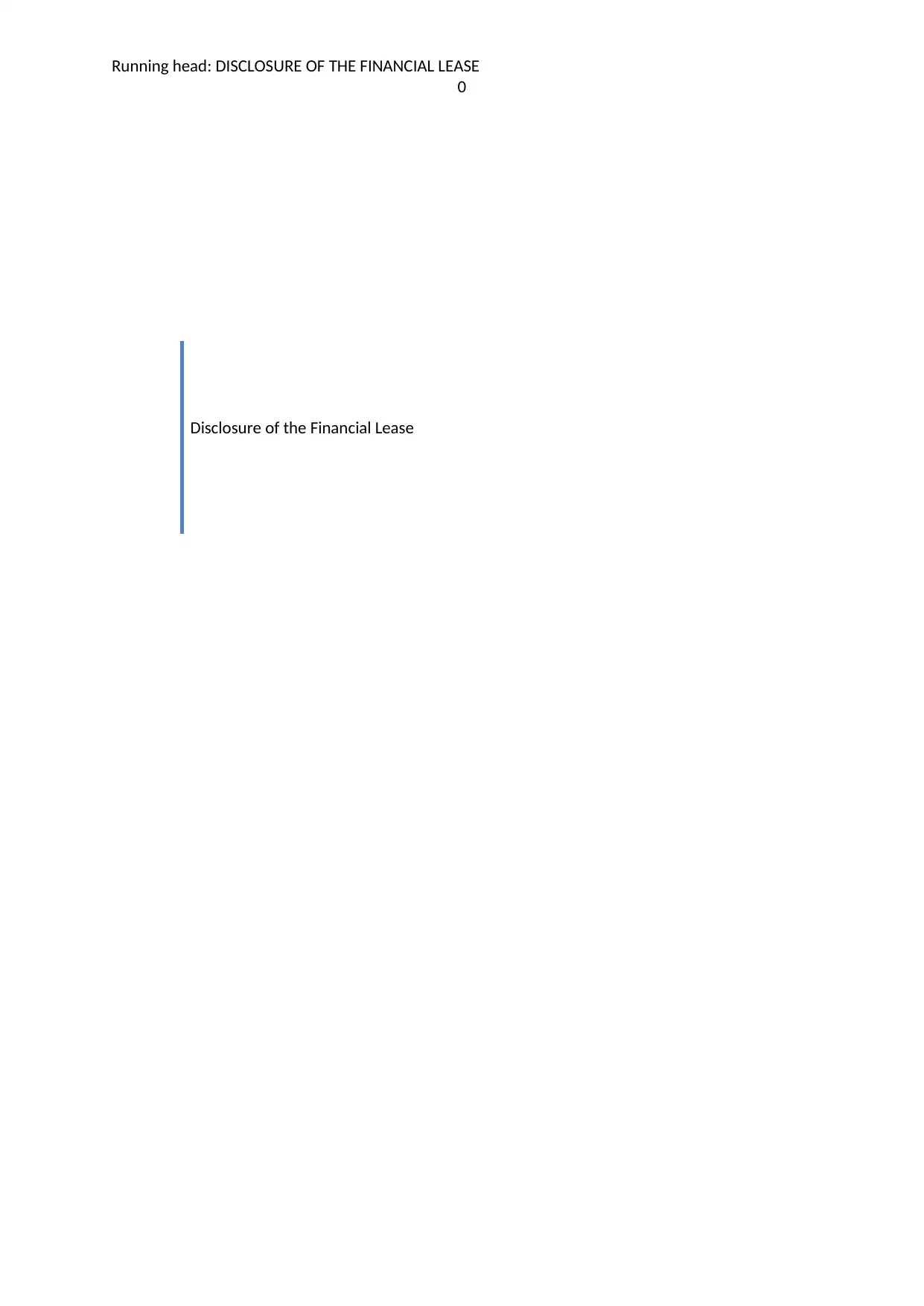
Running head: DISCLOSURE OF THE FINANCIAL LEASE
0
Disclosure of the Financial Lease
0
Disclosure of the Financial Lease
Paraphrase This Document
Need a fresh take? Get an instant paraphrase of this document with our AI Paraphraser
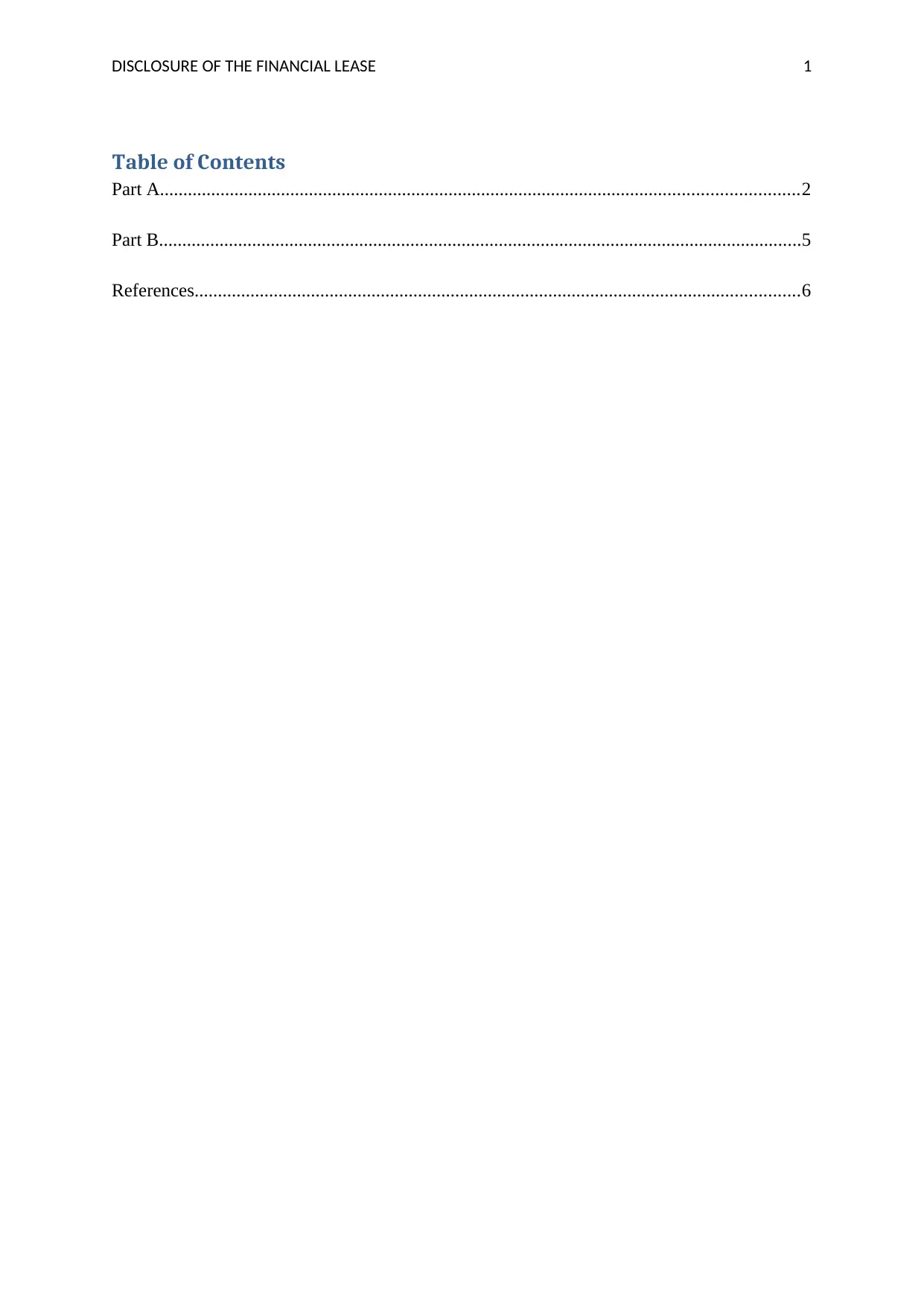
DISCLOSURE OF THE FINANCIAL LEASE 1
Table of Contents
Part A.........................................................................................................................................2
Part B..........................................................................................................................................5
References..................................................................................................................................6
Table of Contents
Part A.........................................................................................................................................2
Part B..........................................................................................................................................5
References..................................................................................................................................6
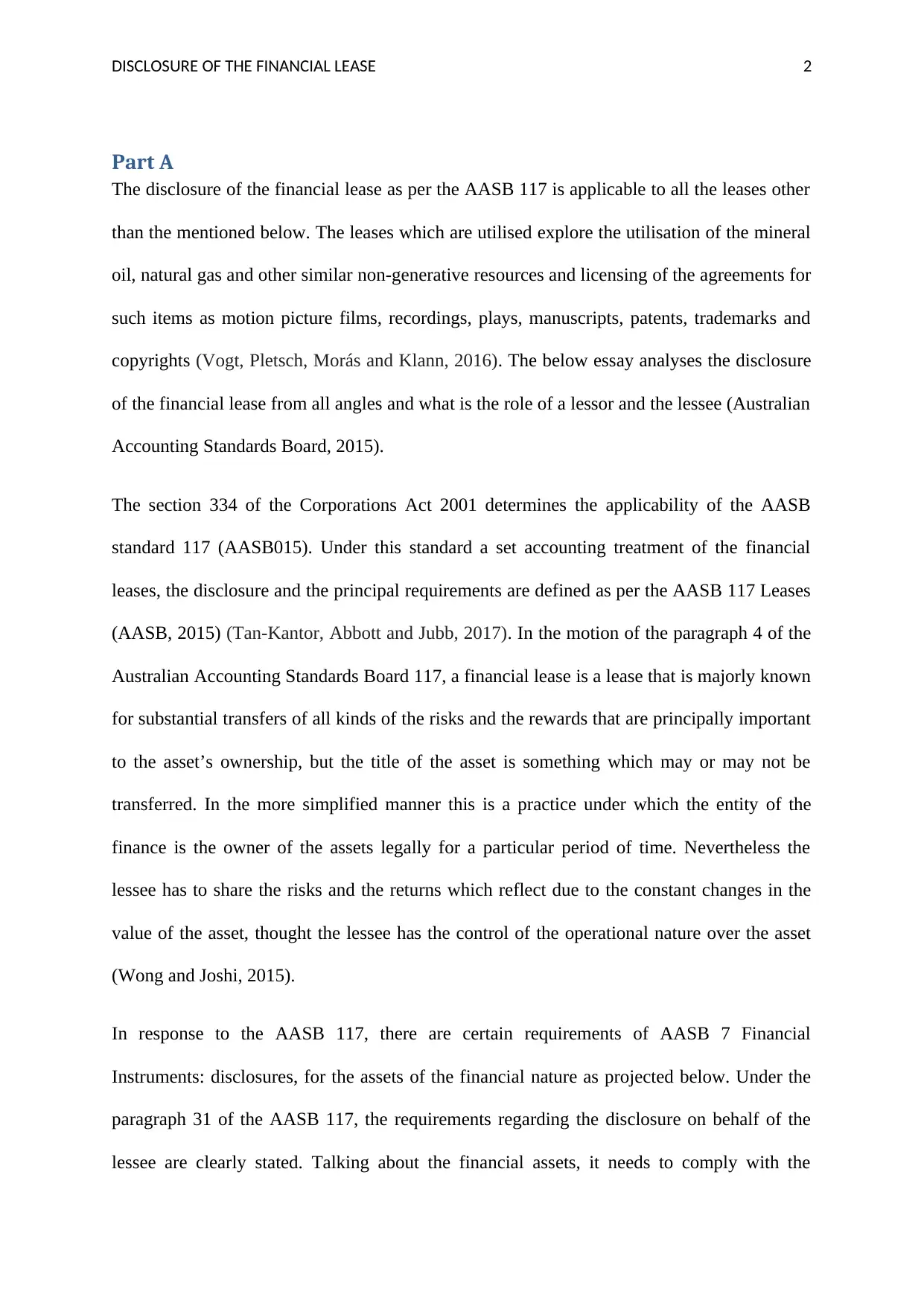
DISCLOSURE OF THE FINANCIAL LEASE 2
Part A
The disclosure of the financial lease as per the AASB 117 is applicable to all the leases other
than the mentioned below. The leases which are utilised explore the utilisation of the mineral
oil, natural gas and other similar non-generative resources and licensing of the agreements for
such items as motion picture films, recordings, plays, manuscripts, patents, trademarks and
copyrights (Vogt, Pletsch, Morás and Klann, 2016). The below essay analyses the disclosure
of the financial lease from all angles and what is the role of a lessor and the lessee (Australian
Accounting Standards Board, 2015).
The section 334 of the Corporations Act 2001 determines the applicability of the AASB
standard 117 (AASB015). Under this standard a set accounting treatment of the financial
leases, the disclosure and the principal requirements are defined as per the AASB 117 Leases
(AASB, 2015) (Tan‐Kantor, Abbott and Jubb, 2017). In the motion of the paragraph 4 of the
Australian Accounting Standards Board 117, a financial lease is a lease that is majorly known
for substantial transfers of all kinds of the risks and the rewards that are principally important
to the asset’s ownership, but the title of the asset is something which may or may not be
transferred. In the more simplified manner this is a practice under which the entity of the
finance is the owner of the assets legally for a particular period of time. Nevertheless the
lessee has to share the risks and the returns which reflect due to the constant changes in the
value of the asset, thought the lessee has the control of the operational nature over the asset
(Wong and Joshi, 2015).
In response to the AASB 117, there are certain requirements of AASB 7 Financial
Instruments: disclosures, for the assets of the financial nature as projected below. Under the
paragraph 31 of the AASB 117, the requirements regarding the disclosure on behalf of the
lessee are clearly stated. Talking about the financial assets, it needs to comply with the
Part A
The disclosure of the financial lease as per the AASB 117 is applicable to all the leases other
than the mentioned below. The leases which are utilised explore the utilisation of the mineral
oil, natural gas and other similar non-generative resources and licensing of the agreements for
such items as motion picture films, recordings, plays, manuscripts, patents, trademarks and
copyrights (Vogt, Pletsch, Morás and Klann, 2016). The below essay analyses the disclosure
of the financial lease from all angles and what is the role of a lessor and the lessee (Australian
Accounting Standards Board, 2015).
The section 334 of the Corporations Act 2001 determines the applicability of the AASB
standard 117 (AASB015). Under this standard a set accounting treatment of the financial
leases, the disclosure and the principal requirements are defined as per the AASB 117 Leases
(AASB, 2015) (Tan‐Kantor, Abbott and Jubb, 2017). In the motion of the paragraph 4 of the
Australian Accounting Standards Board 117, a financial lease is a lease that is majorly known
for substantial transfers of all kinds of the risks and the rewards that are principally important
to the asset’s ownership, but the title of the asset is something which may or may not be
transferred. In the more simplified manner this is a practice under which the entity of the
finance is the owner of the assets legally for a particular period of time. Nevertheless the
lessee has to share the risks and the returns which reflect due to the constant changes in the
value of the asset, thought the lessee has the control of the operational nature over the asset
(Wong and Joshi, 2015).
In response to the AASB 117, there are certain requirements of AASB 7 Financial
Instruments: disclosures, for the assets of the financial nature as projected below. Under the
paragraph 31 of the AASB 117, the requirements regarding the disclosure on behalf of the
lessee are clearly stated. Talking about the financial assets, it needs to comply with the
⊘ This is a preview!⊘
Do you want full access?
Subscribe today to unlock all pages.

Trusted by 1+ million students worldwide
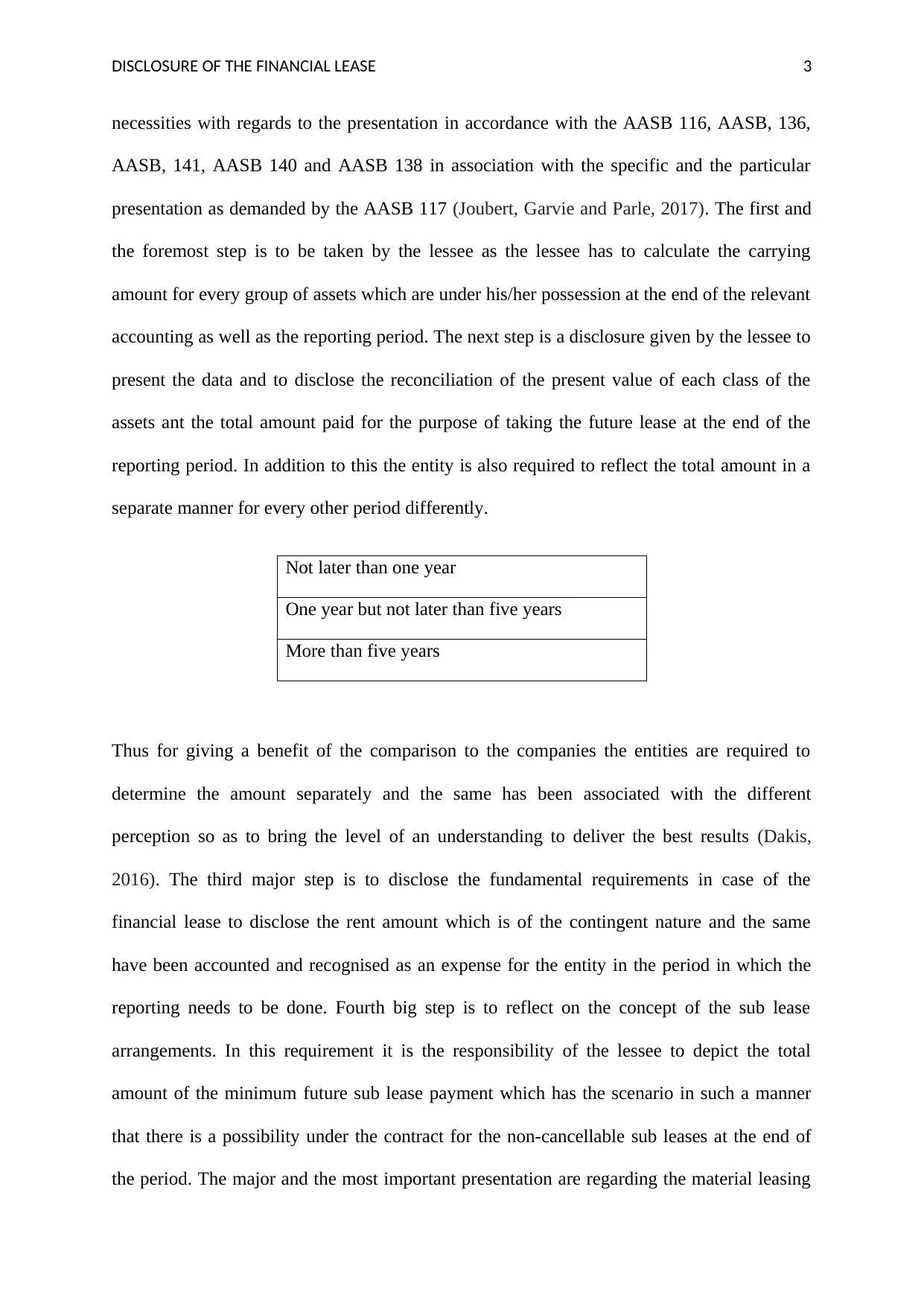
DISCLOSURE OF THE FINANCIAL LEASE 3
necessities with regards to the presentation in accordance with the AASB 116, AASB, 136,
AASB, 141, AASB 140 and AASB 138 in association with the specific and the particular
presentation as demanded by the AASB 117 (Joubert, Garvie and Parle, 2017). The first and
the foremost step is to be taken by the lessee as the lessee has to calculate the carrying
amount for every group of assets which are under his/her possession at the end of the relevant
accounting as well as the reporting period. The next step is a disclosure given by the lessee to
present the data and to disclose the reconciliation of the present value of each class of the
assets ant the total amount paid for the purpose of taking the future lease at the end of the
reporting period. In addition to this the entity is also required to reflect the total amount in a
separate manner for every other period differently.
Not later than one year
One year but not later than five years
More than five years
Thus for giving a benefit of the comparison to the companies the entities are required to
determine the amount separately and the same has been associated with the different
perception so as to bring the level of an understanding to deliver the best results (Dakis,
2016). The third major step is to disclose the fundamental requirements in case of the
financial lease to disclose the rent amount which is of the contingent nature and the same
have been accounted and recognised as an expense for the entity in the period in which the
reporting needs to be done. Fourth big step is to reflect on the concept of the sub lease
arrangements. In this requirement it is the responsibility of the lessee to depict the total
amount of the minimum future sub lease payment which has the scenario in such a manner
that there is a possibility under the contract for the non-cancellable sub leases at the end of
the period. The major and the most important presentation are regarding the material leasing
necessities with regards to the presentation in accordance with the AASB 116, AASB, 136,
AASB, 141, AASB 140 and AASB 138 in association with the specific and the particular
presentation as demanded by the AASB 117 (Joubert, Garvie and Parle, 2017). The first and
the foremost step is to be taken by the lessee as the lessee has to calculate the carrying
amount for every group of assets which are under his/her possession at the end of the relevant
accounting as well as the reporting period. The next step is a disclosure given by the lessee to
present the data and to disclose the reconciliation of the present value of each class of the
assets ant the total amount paid for the purpose of taking the future lease at the end of the
reporting period. In addition to this the entity is also required to reflect the total amount in a
separate manner for every other period differently.
Not later than one year
One year but not later than five years
More than five years
Thus for giving a benefit of the comparison to the companies the entities are required to
determine the amount separately and the same has been associated with the different
perception so as to bring the level of an understanding to deliver the best results (Dakis,
2016). The third major step is to disclose the fundamental requirements in case of the
financial lease to disclose the rent amount which is of the contingent nature and the same
have been accounted and recognised as an expense for the entity in the period in which the
reporting needs to be done. Fourth big step is to reflect on the concept of the sub lease
arrangements. In this requirement it is the responsibility of the lessee to depict the total
amount of the minimum future sub lease payment which has the scenario in such a manner
that there is a possibility under the contract for the non-cancellable sub leases at the end of
the period. The major and the most important presentation are regarding the material leasing
Paraphrase This Document
Need a fresh take? Get an instant paraphrase of this document with our AI Paraphraser
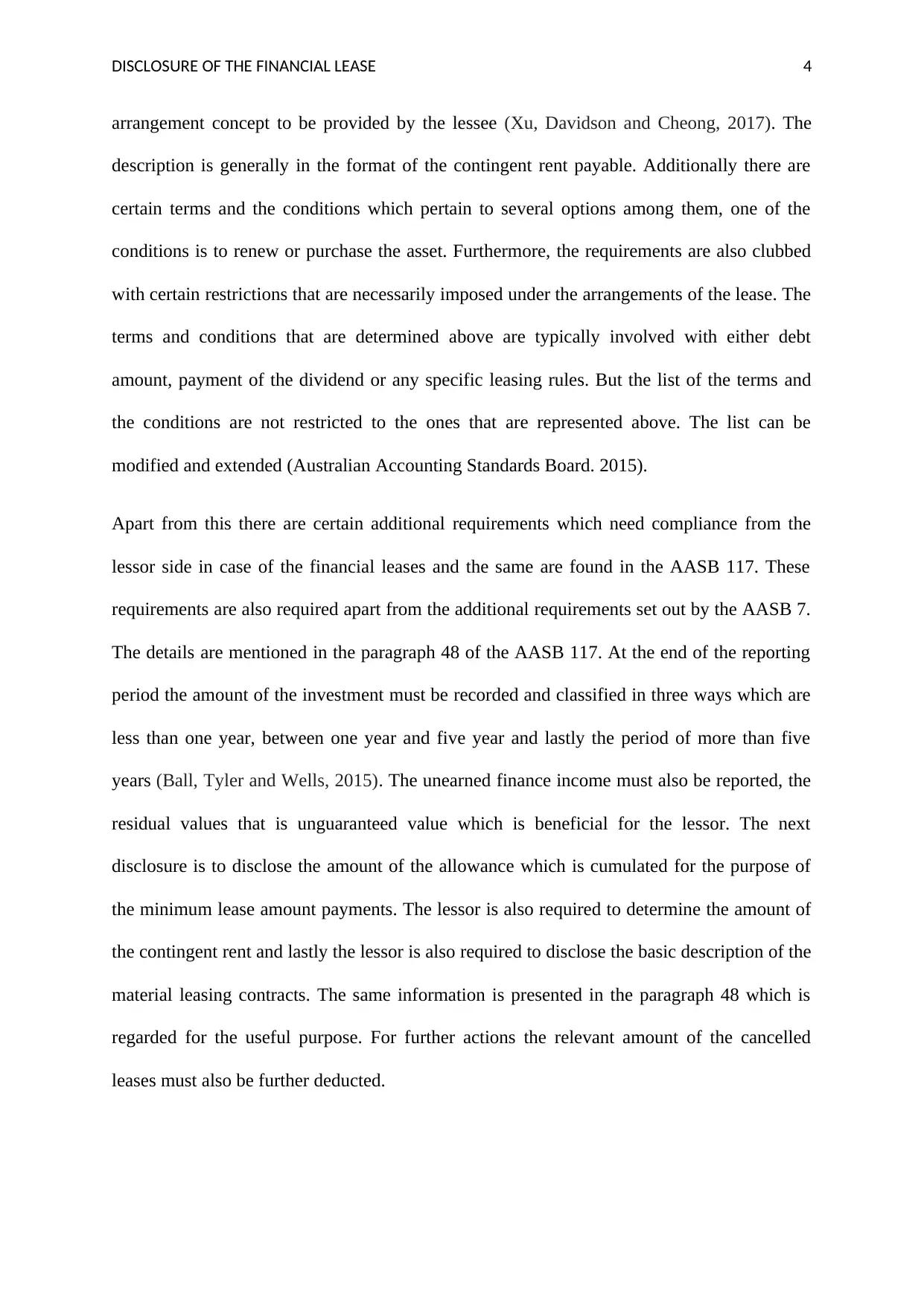
DISCLOSURE OF THE FINANCIAL LEASE 4
arrangement concept to be provided by the lessee (Xu, Davidson and Cheong, 2017). The
description is generally in the format of the contingent rent payable. Additionally there are
certain terms and the conditions which pertain to several options among them, one of the
conditions is to renew or purchase the asset. Furthermore, the requirements are also clubbed
with certain restrictions that are necessarily imposed under the arrangements of the lease. The
terms and conditions that are determined above are typically involved with either debt
amount, payment of the dividend or any specific leasing rules. But the list of the terms and
the conditions are not restricted to the ones that are represented above. The list can be
modified and extended (Australian Accounting Standards Board. 2015).
Apart from this there are certain additional requirements which need compliance from the
lessor side in case of the financial leases and the same are found in the AASB 117. These
requirements are also required apart from the additional requirements set out by the AASB 7.
The details are mentioned in the paragraph 48 of the AASB 117. At the end of the reporting
period the amount of the investment must be recorded and classified in three ways which are
less than one year, between one year and five year and lastly the period of more than five
years (Ball, Tyler and Wells, 2015). The unearned finance income must also be reported, the
residual values that is unguaranteed value which is beneficial for the lessor. The next
disclosure is to disclose the amount of the allowance which is cumulated for the purpose of
the minimum lease amount payments. The lessor is also required to determine the amount of
the contingent rent and lastly the lessor is also required to disclose the basic description of the
material leasing contracts. The same information is presented in the paragraph 48 which is
regarded for the useful purpose. For further actions the relevant amount of the cancelled
leases must also be further deducted.
arrangement concept to be provided by the lessee (Xu, Davidson and Cheong, 2017). The
description is generally in the format of the contingent rent payable. Additionally there are
certain terms and the conditions which pertain to several options among them, one of the
conditions is to renew or purchase the asset. Furthermore, the requirements are also clubbed
with certain restrictions that are necessarily imposed under the arrangements of the lease. The
terms and conditions that are determined above are typically involved with either debt
amount, payment of the dividend or any specific leasing rules. But the list of the terms and
the conditions are not restricted to the ones that are represented above. The list can be
modified and extended (Australian Accounting Standards Board. 2015).
Apart from this there are certain additional requirements which need compliance from the
lessor side in case of the financial leases and the same are found in the AASB 117. These
requirements are also required apart from the additional requirements set out by the AASB 7.
The details are mentioned in the paragraph 48 of the AASB 117. At the end of the reporting
period the amount of the investment must be recorded and classified in three ways which are
less than one year, between one year and five year and lastly the period of more than five
years (Ball, Tyler and Wells, 2015). The unearned finance income must also be reported, the
residual values that is unguaranteed value which is beneficial for the lessor. The next
disclosure is to disclose the amount of the allowance which is cumulated for the purpose of
the minimum lease amount payments. The lessor is also required to determine the amount of
the contingent rent and lastly the lessor is also required to disclose the basic description of the
material leasing contracts. The same information is presented in the paragraph 48 which is
regarded for the useful purpose. For further actions the relevant amount of the cancelled
leases must also be further deducted.
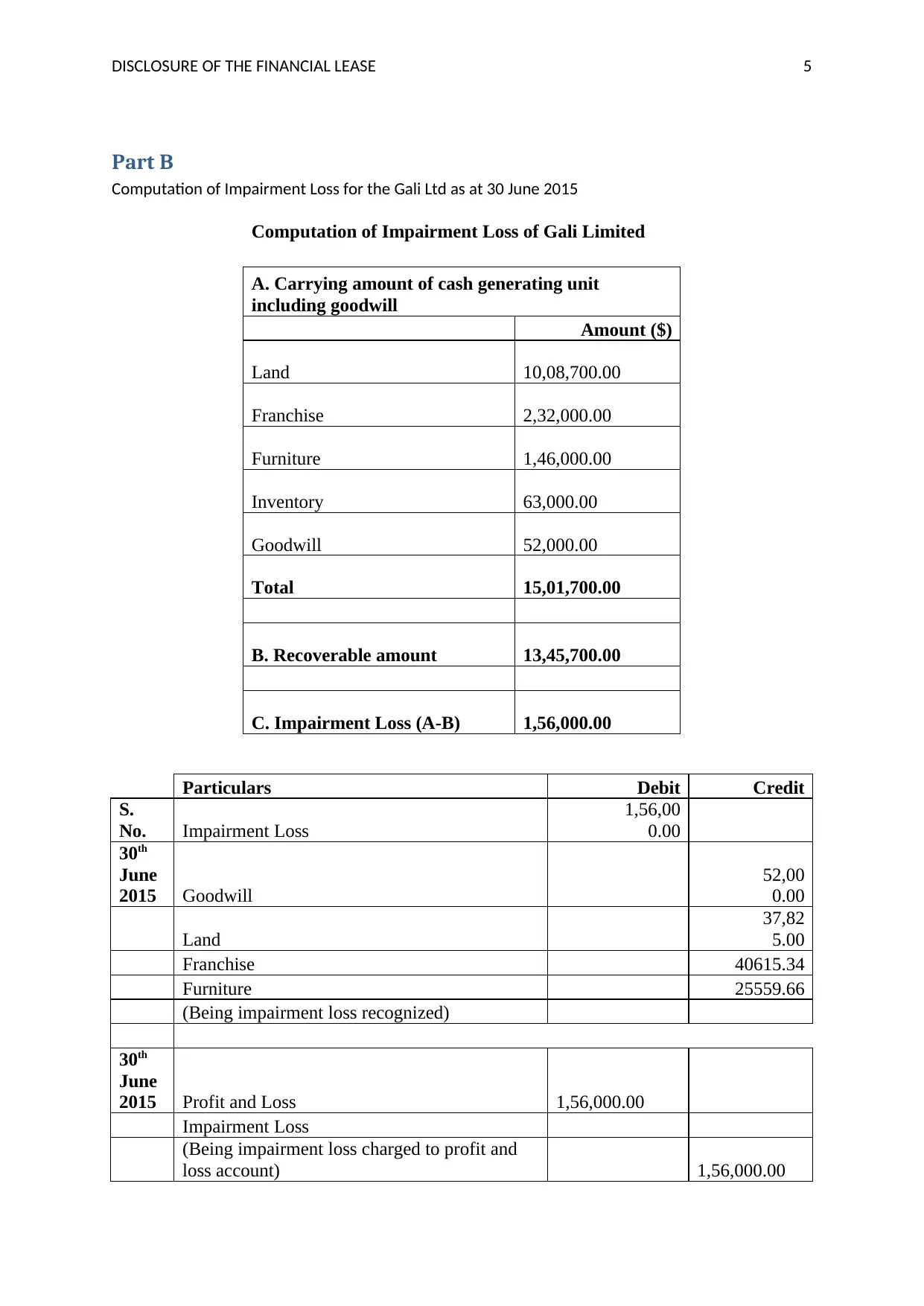
DISCLOSURE OF THE FINANCIAL LEASE 5
Part B
Computation of Impairment Loss for the Gali Ltd as at 30 June 2015
Computation of Impairment Loss of Gali Limited
A. Carrying amount of cash generating unit
including goodwill
Amount ($)
Land 10,08,700.00
Franchise 2,32,000.00
Furniture 1,46,000.00
Inventory 63,000.00
Goodwill 52,000.00
Total 15,01,700.00
B. Recoverable amount 13,45,700.00
C. Impairment Loss (A-B) 1,56,000.00
Particulars Debit Credit
S.
No. Impairment Loss
1,56,00
0.00
30th
June
2015 Goodwill
52,00
0.00
Land
37,82
5.00
Franchise 40615.34
Furniture 25559.66
(Being impairment loss recognized)
30th
June
2015 Profit and Loss 1,56,000.00
Impairment Loss
(Being impairment loss charged to profit and
loss account) 1,56,000.00
Part B
Computation of Impairment Loss for the Gali Ltd as at 30 June 2015
Computation of Impairment Loss of Gali Limited
A. Carrying amount of cash generating unit
including goodwill
Amount ($)
Land 10,08,700.00
Franchise 2,32,000.00
Furniture 1,46,000.00
Inventory 63,000.00
Goodwill 52,000.00
Total 15,01,700.00
B. Recoverable amount 13,45,700.00
C. Impairment Loss (A-B) 1,56,000.00
Particulars Debit Credit
S.
No. Impairment Loss
1,56,00
0.00
30th
June
2015 Goodwill
52,00
0.00
Land
37,82
5.00
Franchise 40615.34
Furniture 25559.66
(Being impairment loss recognized)
30th
June
2015 Profit and Loss 1,56,000.00
Impairment Loss
(Being impairment loss charged to profit and
loss account) 1,56,000.00
⊘ This is a preview!⊘
Do you want full access?
Subscribe today to unlock all pages.

Trusted by 1+ million students worldwide
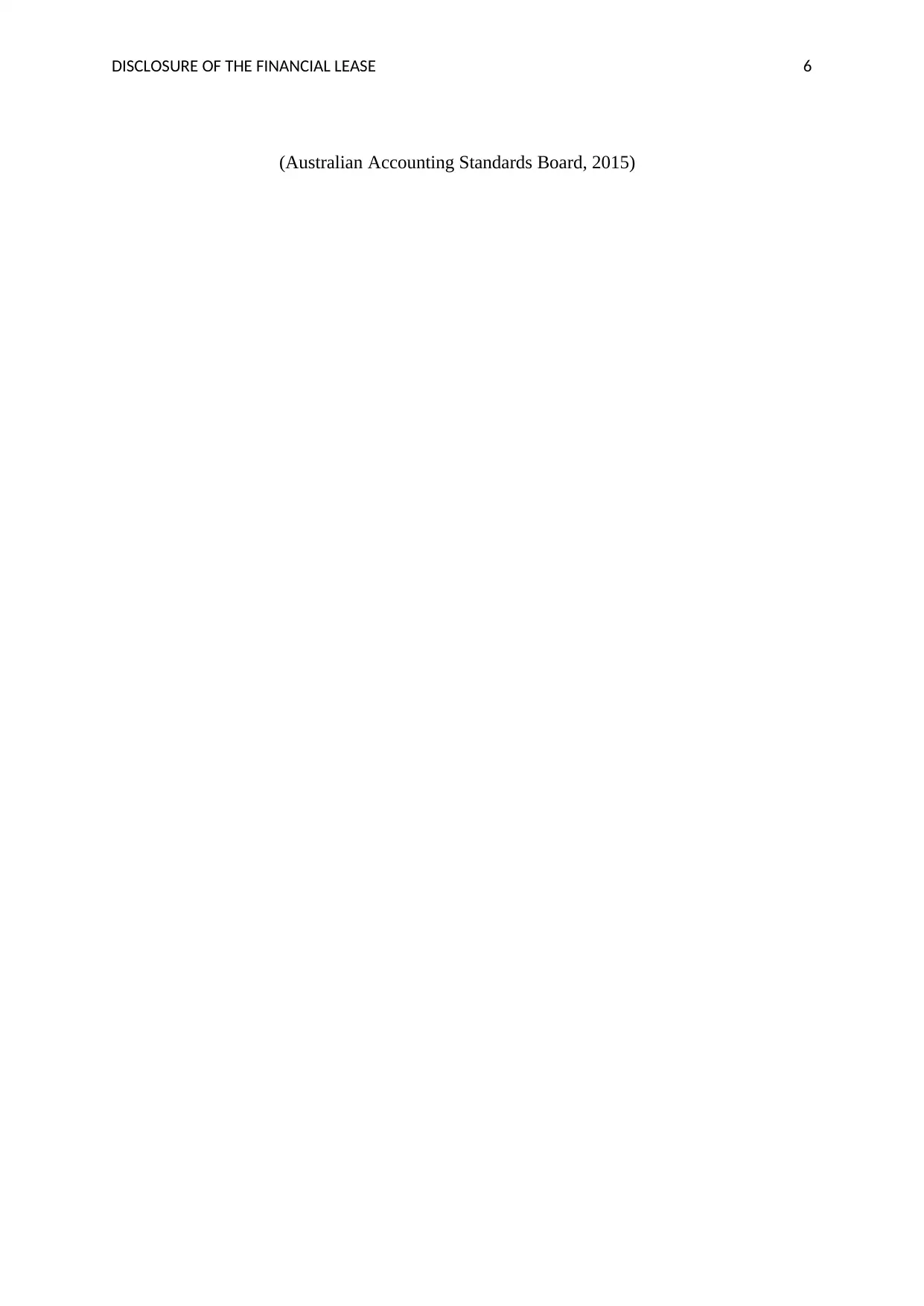
DISCLOSURE OF THE FINANCIAL LEASE 6
(Australian Accounting Standards Board, 2015)
(Australian Accounting Standards Board, 2015)
Paraphrase This Document
Need a fresh take? Get an instant paraphrase of this document with our AI Paraphraser
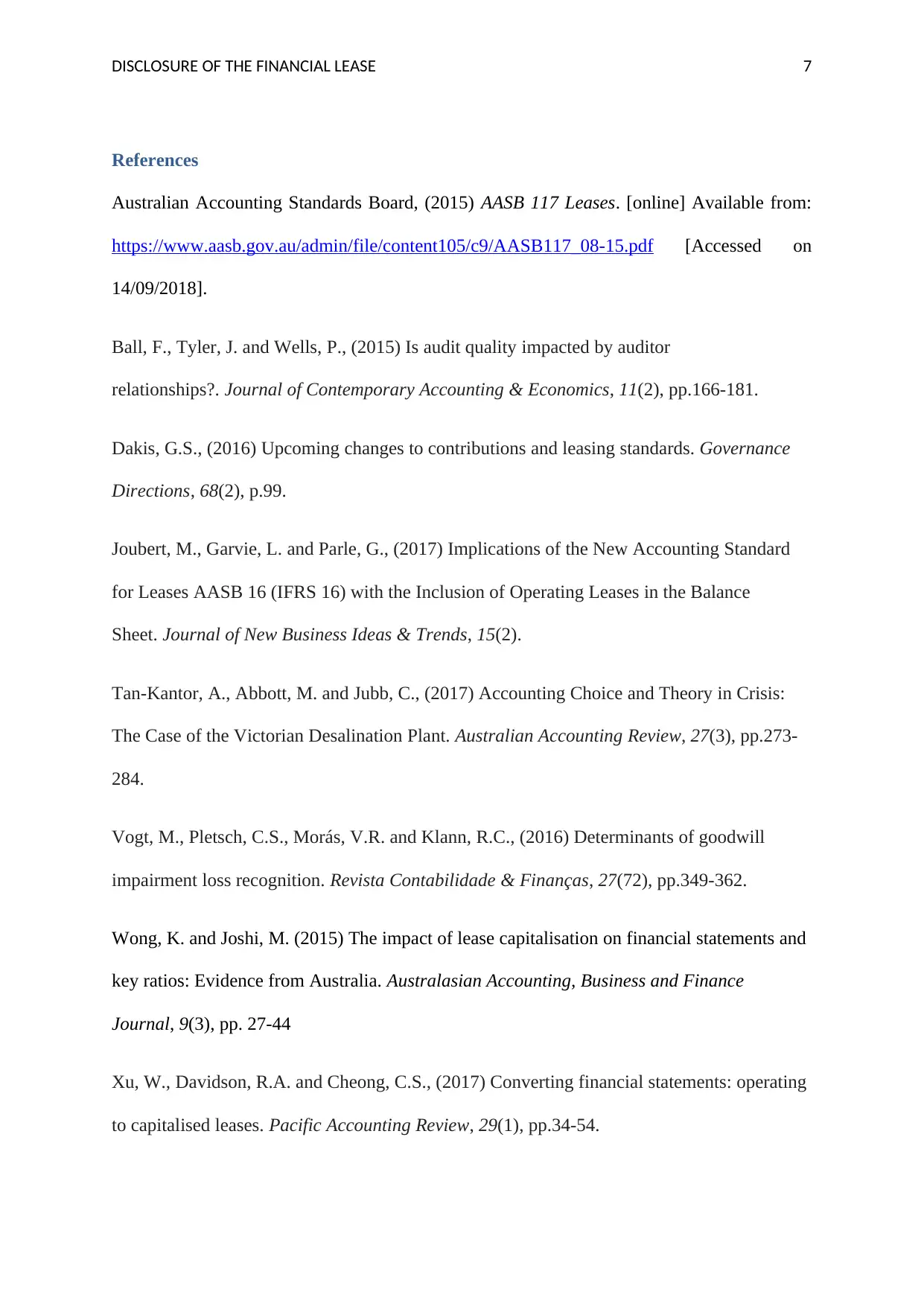
DISCLOSURE OF THE FINANCIAL LEASE 7
References
Australian Accounting Standards Board, (2015) AASB 117 Leases. [online] Available from:
https://www.aasb.gov.au/admin/file/content105/c9/AASB117_08-15.pdf [Accessed on
14/09/2018].
Ball, F., Tyler, J. and Wells, P., (2015) Is audit quality impacted by auditor
relationships?. Journal of Contemporary Accounting & Economics, 11(2), pp.166-181.
Dakis, G.S., (2016) Upcoming changes to contributions and leasing standards. Governance
Directions, 68(2), p.99.
Joubert, M., Garvie, L. and Parle, G., (2017) Implications of the New Accounting Standard
for Leases AASB 16 (IFRS 16) with the Inclusion of Operating Leases in the Balance
Sheet. Journal of New Business Ideas & Trends, 15(2).
Tan‐Kantor, A., Abbott, M. and Jubb, C., (2017) Accounting Choice and Theory in Crisis:
The Case of the Victorian Desalination Plant. Australian Accounting Review, 27(3), pp.273-
284.
Vogt, M., Pletsch, C.S., Morás, V.R. and Klann, R.C., (2016) Determinants of goodwill
impairment loss recognition. Revista Contabilidade & Finanças, 27(72), pp.349-362.
Wong, K. and Joshi, M. (2015) The impact of lease capitalisation on financial statements and
key ratios: Evidence from Australia. Australasian Accounting, Business and Finance
Journal, 9(3), pp. 27-44
Xu, W., Davidson, R.A. and Cheong, C.S., (2017) Converting financial statements: operating
to capitalised leases. Pacific Accounting Review, 29(1), pp.34-54.
References
Australian Accounting Standards Board, (2015) AASB 117 Leases. [online] Available from:
https://www.aasb.gov.au/admin/file/content105/c9/AASB117_08-15.pdf [Accessed on
14/09/2018].
Ball, F., Tyler, J. and Wells, P., (2015) Is audit quality impacted by auditor
relationships?. Journal of Contemporary Accounting & Economics, 11(2), pp.166-181.
Dakis, G.S., (2016) Upcoming changes to contributions and leasing standards. Governance
Directions, 68(2), p.99.
Joubert, M., Garvie, L. and Parle, G., (2017) Implications of the New Accounting Standard
for Leases AASB 16 (IFRS 16) with the Inclusion of Operating Leases in the Balance
Sheet. Journal of New Business Ideas & Trends, 15(2).
Tan‐Kantor, A., Abbott, M. and Jubb, C., (2017) Accounting Choice and Theory in Crisis:
The Case of the Victorian Desalination Plant. Australian Accounting Review, 27(3), pp.273-
284.
Vogt, M., Pletsch, C.S., Morás, V.R. and Klann, R.C., (2016) Determinants of goodwill
impairment loss recognition. Revista Contabilidade & Finanças, 27(72), pp.349-362.
Wong, K. and Joshi, M. (2015) The impact of lease capitalisation on financial statements and
key ratios: Evidence from Australia. Australasian Accounting, Business and Finance
Journal, 9(3), pp. 27-44
Xu, W., Davidson, R.A. and Cheong, C.S., (2017) Converting financial statements: operating
to capitalised leases. Pacific Accounting Review, 29(1), pp.34-54.
1 out of 8
Related Documents
Your All-in-One AI-Powered Toolkit for Academic Success.
+13062052269
info@desklib.com
Available 24*7 on WhatsApp / Email
![[object Object]](/_next/static/media/star-bottom.7253800d.svg)
Unlock your academic potential
Copyright © 2020–2025 A2Z Services. All Rights Reserved. Developed and managed by ZUCOL.



